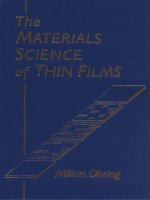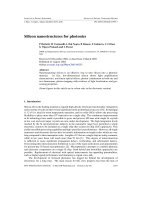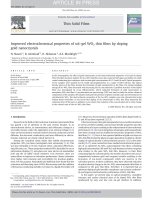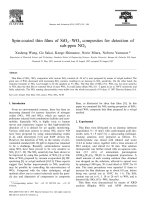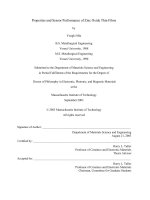- Trang chủ >>
- Khoa Học Tự Nhiên >>
- Vật lý
functional thin films and nanostructures for sensors. synthesis, physics, and applications
Bạn đang xem bản rút gọn của tài liệu. Xem và tải ngay bản đầy đủ của tài liệu tại đây (4.72 MB, 224 trang )
Functional Thin Films and
Nanostructures for Sensors
Integrated Analytical Systems
Series Editor: Dr. Radislav A. Potyrailo
GE Global Research, Niskayuna, NY
For other titles published in this series, go to
www.springer.com/series/7427
Anis Zribi
•
Jeffrey Fortin
Editors
Functional Thin Films and
Nanostructures for Sensors
Synthesis, Physics, and Applications
Editors
Anis Zribi
United Technologies Corporation
Fire and Security
Kidde Detection Technology Research
Development and Engineering
Colorado Springs, CO
USA
Jeffrey Fortin
GE Global Research Center
Micro and Nano Structures Technologies
Niskayuna, NY
USA
ISBN: 978-0-387-36229-8
e-ISBN: 978-0-387-68609-7
DOI: 10.1007/978-0-387-68609-7
Library of Congress Control Number: 2008944096
© Springer Science+Business Media, LLC 2009
All rights reserved. This work may not be translated or copied in whole or in part without the written
permission of the publisher (Springer Science+Business Media, LLC, 233 Spring Street, New York,
NY 10013, USA), except for brief excerpts in connection with reviews or scholarly analysis. Use in
connection with any form of information storage and retrieval, electronic adaptation, computer software,
or by similar or dissimilar methodology now known or hereafter developed is forbidden.
The use in this publication of trade names, trademarks, service marks, and similar terms, even if they
are not identified as such, is not to be taken as an expression of opinion as to whether or not they are
subject to proprietary rights.
Printed on acid-free paper
springer.com
To our families and parents.
Olena, Nadia
Michelle, Abi, Libby
Foreword
In recent years, there has been a convergence of fundamental materials science and
materials processing methods. This convergence, although highly interdisciplinary
in nature, has been brought about by technologies such as bandgap engineering and
related techniques that have led to application-specific devices such as lab-on-achip and system-on-a-chip. The demand for reduced device size, device portability,
and low power dissipation coupled with high speed of operation continues to dictate
terms and conditions for the evolution of nanotechnology. The present trend in
approaches to systems manufacturing continues to focus on integration of multifunctionalities on the same chip. These functionalities include, for example, onboard laser sources, sensors, and amplifiers. Both the military and civilian markets
continue to drive the research and development component. In recent years, the
emergency preparedness guidance systems have added excitement and curiosity to
this expanding industry. The outgrowth of technologies of interest for emergency
preparedness includes the development of terahertz sources and detectors and systems for detection of explosives and concealed weapons, among others.
Sensors made from bulk materials have been around for a long time. Enormous
advances in the processing technologies of thin films have led to the ability to
manufacture application-specific functional thin films. These include transparent
electrodes and antireflection films such as indium tin oxide, which serve as interface components between humans and electronic devices, or optical circuit elements used in optical communication networks, or as contacts and antireflection
coatings in solar cells. Products are also being developed with magneto-optical,
electrochromic, or UV material for their use as functional thin films in optics.
Photonic crystals contain a variety of functional thin films; they require processing
of thin films under very stringent control of their structure and properties.
For microelectromechanical systems (MEMS), in addition to silicon-based technology, ferroelectric thin films are being used in the fabrication of microactuators
and micromotors, capacitors, and other thin-film devices. Functional thin films are
being used in the manufacture of devices such as surface acoustic wave (SAW)
devices for high-frequency telecommunications filtering, infrared detectors, pressure sensors, accelerometers, force sensors, vibration, thickness, and chemical sensors and biosensors. The reduction in size from bulk to micro- and nanostructured
transducers, while promising high sensitivity, high speed, and increased selectivity,
vii
viii
Foreword
requires new design considerations that should consider factors such as integration
with other devices and device lifetime.
Functional thin films offer an enormous infrastructure for a highly interdisciplinary integration of inorganic/semiconducting, organic/bio, and electronic/optoelectronic sensor systems. The field is constantly evolving and will continue to do so
by absorbing novel materials approaches such as carbon nanotubes, high Tc superconductors, ferroelectrics, and thermoelectrics.
The chapters in this book are designed to give the reader the big picture, from
the design phase to the implementation and realization of a transducer. Every effort
has been made to include the state-of-the-art in each chapter. The intended audience
is scientists, researchers, and engineers, however, graduate students will find the
book to be very useful in their research and understanding of sensors and beyond.
The editors and contributors are leading researchers in industry and academia in
their subject areas.
Newark, New Jersey
February 2008
N. M. Ravindra
Series Preface
In my career I’ve found that “thinking outside the box” works
better if I know what’s “inside the box.”
Dave Grusin, composer and jazz musician
Different people think in different time frames: scientists think
in decades, engineers think in years, and investors think in
quarters.
Stan Williams, Director of Quantum Science
Research,Hewlett Packard Laboratories
Everything can be made smaller, never mind physics;
Everything can be made more efficient, never mind
thermodynamics;
Everything will be more expensive, never mind common sense.
Tomas Hirschfeld, pioneer of industrial spectroscopy
Integrated Analytical Systems
Series Editor: Dr. Radislav A. Potyrailo, GE Global Research, Niskayuna, NY
The book series Integrated Analytical Systems offers the most recent advances in all
key aspects of development and applications of modern instrumentation for chemical and biological analysis. The key development aspects include: (i) innovations in
sample introduction through micro- and nanofluidic designs; (ii) new types and
methods of fabrication of physical transducers and ion detectors; (iii) materials for
sensors that became available due to the breakthroughs in biology, combinatorial
materials science, and nanotechnology; and (iv) innovative data processing and
mining methodologies that provide dramatically reduced rates of false alarms.
A multidisciplinary effort is required to design and build instruments with previously unavailable capabilities for demanding new applications. Instruments with
more sensitivity are required today to analyze ultratrace levels of environmental
pollutants, pathogens in water, and low vapor pressure energetic materials in air.
ix
x
Series Preface
Sensor systems with faster response times are desired to monitor transient in vivo
events and bedside patients. More selective instruments are sought to analyze
specific proteins in vitro and analyze ambient urban or battlefield air. For these and
many other applications, new analytical instrumentation is urgently needed. This
book series is intended to be a primary source of both fundamental and practical
information of where analytical instrumentation technologies are now and where
they are headed in the future.
Looking back over peer-reviewed technical articles from several decades ago,
one notices that the overwhelming majority of publications on chemical analysis
has been related to chemical and biological sensors and has originated from departments of chemistry in universities and divisions of life sciences of governmental
laboratories. Since then, the number of disciplines has dramatically increased
because of the ever-expanding needs for miniaturization (e.g., for in vivo cell analysis, embedding into soldier uniforms), lower power consumption (e.g., harvested
power), and the ability to operate in complex environments (e.g., whole blood,
industrial water, or battlefield air) for more selective, sensitive, and rapid determination of chemical and biological species. Compact analytical systems that have a
sensor as one of the system components are becoming more important than individual sensors. Thus, in addition to traditional sensor approaches, a variety of new
themes has been introduced to achieve an attractive goal of analyzing chemical and
biological species on the micro- and nanoscale.
Preface
Anyone with the most cursory knowledge of sensors must have had a chance to use
such devices at some point in their life or career. Whether to collect data in a lab
course, to automate an otherwise tedious process, to improve the efficiency of a
delicately tuned process, or to do something as mundane as taking a family picture,
sensors have become an integral part of our environment and our daily lives.
Charge-coupled devices also known as CCD photodetector arrays, for example,
have revolutionized photography, astronomy, spectroscopy, X-ray diffraction, and
medical imaging to name but a few. A number of scientific discoveries have been
enabled by CCDs including the possibility to determine molecular and lattice structures at intermediate stages of a chemical synthesis or a structural transformation.
At the core of the widespread adoption of sensors are their rapidly decreasing footprint and cost and increased functionality. The miniaturization of solid-state devices
in general and sensors in particular was made possible thanks to significant transformations and a large number of incremental and disruptive inventions in the area
of thin-film and nanostructure science and fabrication technologies.
Thin films and nanostructures can play multiple roles in a sensor including
structural support, reliability enhancement, filtering, and transduction. Thin films
and nanostructures are called functional when they fulfill a function other than
structural support. These micro- and nanostructured materials have applications
that extend far beyond sensing to data storage, lighting, displays, hydrophobic coatings, decoration, and a large number of other fields that are outside the scope of this
book. In this book, these materials are discussed in the context of transduction and
how they contributed to the current sensor revolution.
Sensor design and fabrication are multidisciplinary and require broad and deep
knowledge in diverse areas of science and engineering such as materials science,
physics, chemistry, biology, and mechanical and electrical engineering. Covering a
subject with so many roots in diverse scientific and engineering disciplines is
undoubtedly a daunting task and any author who attempts it will do so with significant trepidation. Aware of the challenge at hand, the editors of this book attempted,
ambitiously, to cover in one volume an account of general sensor theory, design
considerations related to the use of functional thin films and nanostructures, and
specific case studies of functional thin films and nanostructure applications in
sensing. Part of our motivation in taking on this task is that no such work, to our
xi
xii
Preface
knowledge, has been published. Having said this, we are strongly familiar with the
large body of publications in this area that we refer to in this book and we are
keenly indebted to the works of many authors in putting this book together.
This book is devoted to teaching the new sensor designer the key steps involved
in developing sound transducer technology from materials selection, to design for
performance, to process development, and finally to integration. Throughout the
chapters, the authors emphasize and highlight the important role played by functional thin films in solving problems and discuss how to take advantage of such
materials to build superior devices. The book is also intended to provide the more
experienced designers with a condensed summary of sensor design methodology
and excellent references that will prove useful in future sensor design endeavors.
To put all of the shared design and fabrication knowledge into perspective and add
a touch of reality to the concepts discussed in Chapters 1 through 4, Chapters 5
through 8 are completely dedicated to putting the theory into practice and demonstrating the whole design process using a number of concrete applications.
February 2008
Anis Zribi
Jeffrey Fortin
Editor Biographies
Anis Zribi is the manager of the Detection Technology Research, Development
and Engineering group at Kidde UTC Fire and Security. Prior to joining UTC, he
was a senior scientist and a principal investigator at the Global Research Center
(GRC) of General Electric where he (leads) led research in the area of Microsystems
and microfluidics for chemical and biological detection. He received an M.S.E.
in physics from the Polytechnic Institute of Engineering (1996 France), an M.S. in
materials physics from Chalmers University of Technology (1998 Sweden) and a
Ph.D. in materials science from the State University of New York (2002 NY). Since
joining GRC in 2002, Dr. Zribi has contributed to and led several projects including
the Nanotechnology Advanced Technology Program, the Photonics Advanced
Technology Program, and a number of MEMS sensors and actuators projects. His
research interests and activities at GRC include MEMS spectrometers, chemical
and biological sensing, magnetic field sensing, medical parameters sensing, fouling
detection, and micro- and nanotransducers. Dr. Zribi holds 7 patents and over 40
pending patent applications in MEMS, photonics, and sensors. He authored or
co-authored more than 32 articles in peer-reviewed journals and conference proceedings and two book chapters.
Jeff Fortin is the manager of the Microsystems and Microfluidics Lab at GE
Global Research in Niskayuna, NY. His team’s charter is to develop and deliver
innovative micro- and nanosystems and microfluidics via the development and
integration of MEMS and NEMS sensing, actuation, and microfluidic technologies,
driving miniaturization, increased performance, portability, and low cost. Jeff holds
a Ph.D. in engineering science from Rensselaer Polytechnic Institute, an M.S. in
physics from RPI, and a B.A. in physics from the University of Southern Maine.
He has over ten years of experience in semiconductor technology, MEMS, and
microsensors. He joined GE GRC in 2000 and since this time his research has
focused on MEMS and microsystems design and fabrication for a variety of
microsensor and microactuator applications for GE. He holds ten patents and has
co-authored over 12 refereed journal articles in the area of MEMS, thin polymer
film development, and chemical vapor deposition as well as eight conference publications. He is also the co-author of a text on chemical vapor deposition polymerization of parylene and is a member of the MRS.
xiii
Contents
1
Sensor Design Guidelines ........................................................................
Anis Zribi
1
2
Transduction Principles...........................................................................
Jeffrey Fortin
17
3
Growth and Synthesis of Nanostructured Thin Films .........................
Yiping Zhao
31
4
Integrated Micromachining Technologies
for Transducer Fabrication .....................................................................
Wei Cheng Tian
65
Applications of Functional Thin Films
and Nanostructures in Gas Sensing .......................................................
Audrey Nelson
85
5
6
Chemical Sensors: New Ideas for the Mature Field .............................
Radislav A. Potyrailo
103
7
Applications of Functional Thin Films for Mechanical Sensing .........
Chang Liu
145
8
Sensing Infrared and Terahertz Regions by Functional Films ...........
Magnus Willander, Victor Ryzhii, and Qingxiang Zhao
167
Index ................................................................................................................
211
xv
Contributors
Jeffrey Fortin
GE Global Research Center
Micro and Nano Structures Technologies
Chang Liu
Northwestern University
Department of Mechanical Engineering
Audry Nelson
GE Sensing, TelAire
Radislav Potyrailo
GE Global Research Center
Vicktor Ryzhii
University of Aizu
Computer Solid State Physics Laboratory
Wei-Cheng Tian
GE Global Research Center
Micro and Nano Structures Technologies
Magnus Willander
Linköping University
Institute of Science and Technology
Qingxiang Zhao
Linköping University
Institute of Science and Technology
Yiping Zhao
University of Georgia
Department of Physics and Astronomy
Anis Zribi
United Technologies Corporation Fire and Security, Kidde Detection
Technology Research, Development and Engineering Colorado Springs,
CO, USA
xvii
Chapter 1
Sensor Design Guidelines
Anis Zribi
Abstract This chapter focuses on introducing fundamental design principles of
transducers, familiarizing readers who are new to this field with the common vocabulary used in describing transducer performance, and providing a succinct historical
background about the implementation of thin films and nanostructures in sensors
and analytical instruments. A systematic methodology and a sequence of guiding
steps to follow in designing a transducer beginning with a concept, through materials
selection, and transducer design and fabrication are presented. These steps are covered
in more detail in subsequent chapters with concrete examples.
The Big Picture
Sensors are ubiquitous in our environment and play essential roles in our everyday
life. Our own view of the world is defined by our senses that enable us to perceive
stimuli from the environment through a network of biological sensors. Tiny hairs in
our inner ears detect the deflection of a membrane as it vibrates in response to
acoustic waves and make it possible for us to hear; photoreceptors in our eyes
enable us to see objects and discern their colors; chemical receptors on the tongue
(known as taste buds) allow us to differentiate between salty, sweet, bitter, and sour.
This fascinating network of biological sensors caters to our organs’ needs to control
certain biological processes and our needs for security and safety.
Driven by the need to better understand our world, to increase the productivity
of industrial processes and machines, and to improve our quality of life, scientists
and engineers constantly seek to develop the necessary measurement tools. These
tools are sensors and instruments that are often inspired by biological sensors and
their functioning principles. Such devices have become essential for advancing
A. Zribi
United Technologies Corporation Fire and Security, Kidde Detection Technology Research,
Development and Engineering 4820 Centennial Blvd, Suite 145, Colorado Springs 80919,
CO, USA
e-mail:
A. Zribi and J. Fortin (eds.), Functional Thin Films and Nanostructures for Sensors,
Integrated Analytical Systems,
DOI: 10.1007/978-0-387-68609-7_1, © Springer Science + Business Media, LLC 2009
1
2
A. Zribi
metrology and science, optimizing and controlling processes, providing security
against known and unknown threats, law enforcement, and health monitoring.
The miniaturization of sensors and analytical instruments is a continuing trend
that finds its roots in nature and its beginnings in miniaturizing mechanical, optical,
and recently electronic devices. The driving forces for sensor miniaturization are
numerous and keep increasing as we encounter and develop new applications for
devices that have become virtually invisible and intangible. Sensor cost and portability are major incentives for miniaturization but additional reasons include faster
response, integration of multiple functions, reduction of occupied space, and lower
device-to-device variability.
Electronic miniaturization, starting with the invention of the transistor in 1947,
played a key role in developing the fabrication processes that stand at the heart of the
new leap in sensor miniaturization. In fact tremendous progress has been made in the
past 20 years in high vacuum technologies, ultra purification processes for raw materials, self-assembly, and material deposition and etching processes with various
degrees of selectivity, high precision, and small feature-patterning techniques. This
progress produced dramatic advances and control over device quality and induced a
technological evolution from the bulk crystalline age to the age of thin films, thin film
multilayers, and nanostructured materials. In this new age, the properties and performance of submicron devices are dominated by surface and interfacial phenomena. This
paradigm shift produced materials with novel or enhanced transduction properties
known as functional thin films and functional nanostructures.
Thin films and nanostructures play an increasingly important role in state-of-the-art
sensors and actuator technologies both as transducers (functional materials) and structural materials. microelectro mechanical (MEM) systems provide a good example of
the growing use of materials confined to submicron dimensions to fulfill numerous and
versatile functions in advanced devices. Doped silicon/polysilicon thin films, for
example, have been implemented as strain gauges in MEM pressure sensor devices
(Petersen 1982), temperature-sensing elements in micromachined thermopiles
(Petersen 1982), ultrasound transmitters in capacitive ultrasound micromachined
transceivers (cMUT; Jin et al. 1998), active alignment actuators in high-accuracy fiberoptic aligners (Petersen 1982), and the list goes on. The growing interest in functional
thin films and nanostructures is not only driven by device miniaturization but also by
the novel and unique set of physical and chemical properties that materials confined to
submicron dimensions exhibit.
In his famous talk before the audience of the 1959 annual meeting of the
American Physical Society, Richard Feynman predicted many of the now proven
advantages of “manipulating and controlling things on a small scale” (Feynman
1959). Since Feynman’s talk, the advantages of scaling devices and materials to
submicronic dimensions have been proven to go beyond a dramatic increase in data
storage density, faster and more intelligent computing, faster heat removal, and
higher natural resonance frequency.
Today, functional thin films and nanostructures are being used and are under
development for use in a wide range of devices, sensors, and actuators. Such devices
include: accelerometers (air bag devices), force sensors, shutters, optical switches,
1
Sensor Design Guidelines
3
optical computation, micromotors, chemical and biological sensors; MEMS devices
such as piezomicroactuators and sensors; very small scale microreaction vessels for
chemical and biological (lab-on-a-chip) sensing; substrates for plasmon resonancebased signal enhancement and amplification, electro-optical devices for thermal
imaging based on the pyroelectric effect, display technologies; pressure mats (piezoelectric thin film); surface acoustic wave (SAW) devices for telecommunications,
chemical and biological detection, and more.
These new applications for functional thin films and nanostructures are enabled by
newly discovered physical and chemical phenomena that underlie the transduction
mechanisms in these materials. In fact, size confinement and the associated symmetry
breaking, interfacial interactions, high surface-to-volume ratio, structural disorder, and
induced entropy have been extensively covered in recent publications. The fundamentals of these effects and their applications in transduction are the topic of numerous
current investigations. Quantum dots, for example, have been demonstrated to exhibit
a lateral quantum confinement that enables direct coupling of normally incident light
with the intraband electronic excitations (Kuo et al. 2001). The geometry of these
nanostructures (height and radius) can be tuned to ensure that the lowest energy of
electronic transition from ground state to first excited state falls within a specific optical
spectrum band. It has also been demonstrated that the confinement significantly
reduces the electronic tunneling rate of these nanostructures. These properties indicate
the potential of quantum dots to be used as low dark current and hence high signal-tonoise ratio photodetectors especially in the near infrared to infrared part of the spectrum where current detectors are prone to thermally induced electronic tunneling. This
and other transduction benefits that emanate from the physical confinement of material
structures are discussed in later chapters of this book.
Sensor Architecture
The basic function of a sensor is to selectively identify and measure a physical,
chemical, or biological parameter such as pressure, light intensity, gas concentration,
or the presence and concentration of a biological analyte. The typical architecture of
a sensor encompasses a transducer or multiple transducers (operating in series or in
parallel) directly exposed to the measurand, acquisition and conditioning electronics,
a power source, a processor, a storage medium, and a display. The transducer plays a
central role in the operation of the sensor: it is essentially an energy converter where
the input energy (mechanical, optical, chemical, biological, electrical) is converted
into an electrical signal most of the time. The electrical signal is then acquired by the
electronics, conditioned, and noise filtered out before processing (e.g., interpolation
using a calibration curve) and finally the data (typically the magnitude of the measurand) are either stored in memory and displayed or routed for action (e.g., alarm) or
simply displayed.
Fig. 1.1 shows a general block diagram that highlights the main subsystems of
a sensor system and the flow of data among the various blocks. The focus of this
4
A. Zribi
Measurand M Sensing
Material
X
Transducer
Y
Y2
Y1
Amplifier
Filter
A/D
Numerical
Value N
Power Block
Processor
Storage
Display
Fig. 1.1 Sensor architecture block diagram
book is on the transducer block and the role that functional thin films and nanostructures are increasingly playing in high-performance transduction.
Depending on the type of transducer, two basic types of sensors can be distinguished: quantitative (analog or digital) and threshold or binary. The two are quite
different in function and in application. A quantitative sensor produces an output
value that is a direct and continuous function of a measurand value. For example, a
thermocouple might have a potential differential of 10 mV at room temperature and
a potential differential of 20 mV 10° above room temperature. Any differential
potential value between these two is possible depending on the particular temperature to which the sensor is exposed. Threshold sensors, on the other hand, have only
two states, often called “on” and “off”. Perhaps the most familiar example of a
threshold sensor is a smoke detector which is triggered to the on position if a fire
erupts and the signal is used to trip an alarm.
Sensor Figures of Merit/Performance Attributes
The wealth of sensor and transducer technologies available to measure the same
measurands (Mi) increases the challenge of evaluating and comparing the performance of sensor devices. Therefore, it is critical to define a set of performance criteria
that the designers can use to develop sensors that meet customer specifications and the
user can use to appraise and contrast the various options. Table 1.1 summarizes the
list of performance attributes that are most commonly used to assess sensor technologies and a more detailed description of these parameters is provided later in
this chapter.
1
Sensor Design Guidelines
5
Table 1.1 Sensor Performance Attributes
Attribute
Denotation
Input dynamic range
Response curve
Sensitivity
Response time
Resolution
Accuracy
Precision
Hysteresis and drift
Selectivity
DM
N = f(M)
S
t
n
H
Se
N
Mimin
Mimax
ng
asi
re
Inc
Mi
Mij
δMi
δN
sing M i
Decrea
Mi
Input Dynamic Range
Fig. 1.2 Typical response curve of a sensor/transducer to a measurand Mi
Input Dynamic Range
The dynamic range of a sensor is the span of measurands that constitute the overall
operating domain for the device. Within this interval, the sensor is supposed to
maintain its properties and reliability characteristics.
Response Curve
Every quantitative sensor is characterized by a response curve that represents the
output of the sensor N versus the measurand M applied to its input. The transducer
response can be linear or nonlinear as shown in Fig. 1.2, but in most cases the sensor electronics are designed to linearize the response curve of the overall sensor in
6
A. Zribi
order to simplify the calibration procedures. Also, it is worth noting that customarily the response of the sensor is normalized with respect to reference values (e.g.,
resistance at room temperature, resonance frequency of the membrane under known
conditions).
Considering all the possible measurands (Mi) and key noise parameters that can
affect the sensor output, the sensor response N can be expressed as
N = ∑ ΔMi
i
∂N
∂M i
(1.1)
given that the different measurands affect the output independently of each other.
Sensitivity
Although seemingly obvious, the definition of sensitivity can be confusing at times.
Looking at the block diagram of the sensor in the first section, each one of the
building blocks of the sensor introduces a term in the overall sensitivity of the
sensor. These are called, following the diagram from input to output:
• Transducer sensitivity
• Amplification
• Analog filter sensitivity
The sensitivity of transducer j to measurand Mi is defined by
i
Stransducer j =
∂N j
∂M i
(1.2)
,
where Mi are all the possible measurands and key noise parameters that can affect
the transducer sensitivity such as temperature and pressure. Nj is a quantity resulting
from the energy transformation performed by transducer j. Transducers in a detector
can operate in parallel or in series. Typically, transducers that operate in parallel are
used for imaging applications, which we are not concerned with within this manuscript.
Assuming the p transducers that make up the transducer block operate in series, the
total transduction block sensitivity to measurand Mi can be expressed by
i
Stransducer
∂N p
∂M i
=
∂N p ∂N p − 2
∂ M p −1 ∂ M p −1
...
p
∂N1
= Π Sk .
j
∂M i k = 1
(1.3)
The amplification A is an intrinsic property of the amplifier and the analog filter
sensitivity is defined in a similar manner to the transducer block by Equation (1.3):
Sfilter =
∂Y2
.
∂Y1
(1.4)
1
Sensor Design Guidelines
7
The overall sensitivity of the device to measurand Mi is defined by the following
equations,
∂Y2
∂M i
(1.5)
∂Y2 ∂Y1 ∂N
.
.
∂Y1 ∂N ∂Mi
(1.6)
Si total =
Si total =
Si total = Sfilter * A * Stransducer .
(1.7)
Response Time
The response time of the device is a cumulative quantity incorporating the response
times of the respective building blocks. It is defined as the transient response of the
sensor when it experiences a step change in the measurand. If ti are the response
times of the various blocks, then the total response time of the sensor is:
t total = t transducer + t filter + t A / D
(1.8)
t total = t transducer + t electronics .
(1.9)
In most diffusion-based chemical and biological sensors, tchemical transducer is the dominant response time in Equations (1.7) and (1.8). Therefore, we typically can ignore
the contributions from electronics and physical transducers. However, this may not
be the case in thin-film or nanostructure-enabled sensors as the response time of the
material is considerably reduced because of the designed nanomorphology of the
material. This simplification is also not an option for physical sensors where the
response time of the transducer is on the same order of magnitude as the other sensor subsystems.
The response time of the whole device is usually estimated as the time required for
a transient output signal to reach a fraction (e.g., 70%) of its steady-state change.
Resolution
The sensor resolution is the smallest change in input that leads to a detectable
change in output. The most general definition is given by Equation (1.10):
Re solution =
N
N
= noi
Lim
M i → noise Si total Si tot
(1.10)
8
A. Zribi
Clearly for nonlinear sensors, the resolution is dependent on the operating point and
can vary if operating conditions vary. Maximum resolution is attained at maximum
sensitivity and minimum noise.
Accuracy
The accuracy of a transducer is the maximum deviation of its output from the value
of the unknown measurand as determined by a gold standard technique. It is a
quantitative indication of the degree of conformity of the sensor to a standard.
Accuracy represents a systematic error or a bias in the sensor and measuring it and
correcting for it are difficult. Transducer calibration is required to account for this
type of error and partially correct it. Long-term changes in the performance of the
transducer because of materials’ aging and wear will affect its accuracy.
Precision
The second type of measurement uncertainty associated with a transducer is
random errors or what is often referred to as precision. Precision is often mistakenly
confounded with accuracy. It quantifies statistical fluctuations in the measurement
and is attributed to variability in the measurement conditions and the limitations of
the selectivity of the sensor towards the measurand of interest. Precision represents
the repeatability of the measurement given the same sample.
Hysteresis and Drift
Hysteresis characterizes the lagging of the sensor response behind the variation of the
measurand. This can be attributed to the sensing material memory and/or to the transducer properties. As a performance specification, hysteresis is defined as the maximum
difference between the upscale and downscale readings on the same artifact during a
full-range traverse in each direction. It is often reported as the ratio (or percentage) of
the difference between the upscale and downscale readings to the full scale.
Drift can be defined as the slow unpredictable change of the sensor output at
constant input. Drift can affect both the signal and noise levels and it can emanate,
for example, from residual stress relaxation, residual diffusion, material aging, and
degradation. Drift in sensors is defined for a specific time interval of interest.
Selectivity
It is typical of a sensor designed to detect variations of a given measurand M to
exhibit secondary internal sensitivities to other measurands (Mi) or noise factors of
1
Sensor Design Guidelines
9
different natures, physical or chemical, as well as biological. In general, selectivity
may be quantified by
p
Se = ∏
j =1
j ≠1
Stjransducer
,
St1ransducer
(1.11)
where Sj is the sensitivity of transducer j to measurand Mi. In many cases, the
sensitivities to the various measurands are interdependent therefore second-order
and cross-terms should be included in the expression of the selectivity.
Sensor Design Considerations
Sensor design is one of the most interdisciplinary technical areas requiring both
breadth and depth of knowledge in materials science, physics, chemistry, biology,
mathematics and statistics, electronics, and packaging. The successful design of a
sensing system requires very good communication between scientists and engineers of different backgrounds.
Much as in any design activity, it is very difficult and undesirable to bind creativity
by a set of design rules or a design methodology. However, past a first stage, focused
on brainstorming, transduction mechanism and materials down-selection and feasibility analysis, a successful design team must have a clear objective and a guiding
design methodology to steer their effort. The typical sensor design steps include:
•
•
•
•
•
•
•
•
•
•
•
Collection and analyses of the device specifications
Transducer selection/invention
Materials selection/invention
Sensor design and modeling
Prototyping
Measurement of materials properties
Prototype testing and model calibration
Design iteration(s)
Final device fabrication
Technology transition to manufacturing
Fabrication process scaleup
The most challenging and least regulated steps are the first three and they are least
covered by the literature. In the next sections, we provide some guidance, concepts,
and ideas to help the new sensor designer make faster progress towards his or her
ultimate goal.
Selection and/or Invention of the Transduction Mechanism
Assuming that the design team is armed with a clear set of specifications for the
desired sensor performance and the operating and storage conditions, the next steps
10
A. Zribi
ought to target the selection or invention of the transducer(s) that can convert the
measurand into an electrical/optical signal. The questions that need to be answered
by the team at this stage are:
1. What specific physical, chemical, and biological properties does the measurand
possess that differentiate it from other potential sensor inputs?
2. For each of the identified characteristics, what are the potential confounding
inputs, which in the future will be identified as noise sources?
3. What type of energy conversion is required to transform the input signal (mechanical, chemical, biological, electromagnetic) to a device output signal (optical or
electrical)?
4. What are the candidate transduction schemes that can be used for the target
measurand?
The final transduction scheme may involve one or multiple transducers operating
in series or parallel (array of detectors). Considering the following criteria can
further refine the list of candidate transduction mechanisms.
1.
2.
3.
4.
Simplicity of the transducer and robustness to failure
Materials requirements dictated by operating environment
Development time
Cost
Selection of Transducer Material
The transducer material properties are important from performance and sensor reliability perspectives. The suite of functional materials available to sensor and
micro-/nanoinstrument designers is rapidly expanding and numerous techniques
have been developed to integrate a large variety of organic and inorganic materials
and their alloys. The wealth of options puts the designer face to face with the challenge of selecting the best-suited materials given a transducer design concept.
Numerous considerations come into play when selecting a transducer material
and they fall into three categories: performance, process compatibility, and reliability.
Although it is very difficult to discuss the performance selection criteria of a transducer in general terms, process compatibility and reliability criteria are common to
all transducers and they are of chemical (chemical resistance, photo definability,
adhesion) and physical nature (rheology, mechanical, dielectric). Depending on the
transducer length scale, whether it falls in the bulk (>100 mm), micro (<100 mm),
or nano range (<100 nm), materials properties and their behaviors and responses to
environmental conditions and stimuli are significantly different.
Over the years, bulk materials properties have been well documented and often
standardized, however, submicron materials properties are still not as well documented and many are being investigated (Srikar and Spearing 2003). Some of the
